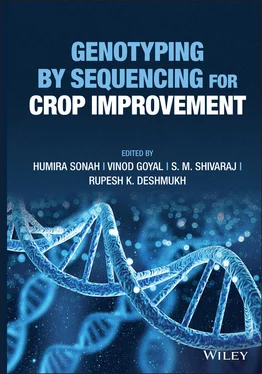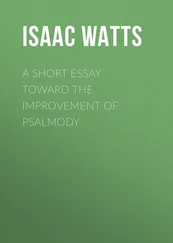Genotyping by Sequencing for Crop Improvement
Здесь есть возможность читать онлайн «Genotyping by Sequencing for Crop Improvement» — ознакомительный отрывок электронной книги совершенно бесплатно, а после прочтения отрывка купить полную версию. В некоторых случаях можно слушать аудио, скачать через торрент в формате fb2 и присутствует краткое содержание. Жанр: unrecognised, на английском языке. Описание произведения, (предисловие) а так же отзывы посетителей доступны на портале библиотеки ЛибКат.
- Название:Genotyping by Sequencing for Crop Improvement
- Автор:
- Жанр:
- Год:неизвестен
- ISBN:нет данных
- Рейтинг книги:4 / 5. Голосов: 1
-
Избранное:Добавить в избранное
- Отзывы:
-
Ваша оценка:
- 80
- 1
- 2
- 3
- 4
- 5
Genotyping by Sequencing for Crop Improvement: краткое содержание, описание и аннотация
Предлагаем к чтению аннотацию, описание, краткое содержание или предисловие (зависит от того, что написал сам автор книги «Genotyping by Sequencing for Crop Improvement»). Если вы не нашли необходимую информацию о книге — напишите в комментариях, мы постараемся отыскать её.
A thoroughly up-to-date exploration of genotyping-by-sequencing technologies and related methods in plant science Genotyping by Sequencing for Crop Improvement,
Genotyping by Sequencing for Crop Improvement
Genotyping by Sequencing for Crop Improvement
Genotyping by Sequencing for Crop Improvement — читать онлайн ознакомительный отрывок
Ниже представлен текст книги, разбитый по страницам. Система сохранения места последней прочитанной страницы, позволяет с удобством читать онлайн бесплатно книгу «Genotyping by Sequencing for Crop Improvement», без необходимости каждый раз заново искать на чём Вы остановились. Поставьте закладку, и сможете в любой момент перейти на страницу, на которой закончили чтение.
Интервал:
Закладка:
1.8 Summary
The DNA‐based molecular markers are widely recognized for their enormous potential in plant breeding and genetic studies. The past few years have seen remarkable developments in the field of molecular markers technology particularly with the emergence of NGS technologies. SNPs have become the choice of markers of present and future based on their genome‐wide abundance, high polymorphism, amenability to high‐throughput automation, and easier analysis. SNPs can be utilized in different genotyping platforms such as GBS, DArT, WGR, SNP arrays, and KASP. Any genotyping platform can be chosen based on the objective of the study and cost concerns. As an example, GBS, WGR, SNP arrays, and KASP can generate similar type of results for genetic diversity analysis; however, KASP and GBS could be cheaper than others. While the development of KASP will depend upon the availability of SNPs particularly in SNP databases, but GBS can be done without any previous information. It has been observed that these recent marker genotyping technologies have accelerated the crop improvement programs particularly in the identification and utilization of novel genes and QTLs.
References
1 Aggarwal, R.K., Brar, D.S., and Khush, G.S. (1997). Two new genomes in the oryza complex identified on the basis of molecular divergence analysis using total genomic hybridization. Molecular & General Genetics 254: 1–12.
2 Akkurt, M., Welter, L., Maul, E. et al. (2007). Development of SCAR markers linked to powdery mildew (Uncinula necator) resistance in grapevine (Vitis vinifera L. and Vitis sp.). Molecular Breeding 19: 103–111.
3 Bachlava, E., Taylor, C.A., Tang, S. et al. (2012). SNP discovery and development of a high‐density genotyping array for sunflower. PLoS One 7 (1): e29814.
4 Batley, J., Barker, G., O’Sullivan, H. et al. (2003). Mining for single nucleotide polymorphisms and insertions/deletions in maize expressed sequence tag data. Plant Physiology 132 (1): 84–91.
5 Bhatia, D. (2020). Advanced quantitative genetics technologies for accelerating plant breeding. In: Accelerated Plant Breeding, vol. I (eds. S.S. Gosal and S.H. Wani). Springer Verlag https://doi.org/10.1007/978‐3‐030‐41866‐3_5.
6 Bhatia, D., Sharma, R., Vikal, Y. et al. (2011). Marker assisted development of bacterial blight resistant, dwarf and high yielding versions of two traditional Basmati rice cultivars. Crop Science 51: 759–770.
7 Bhatia, D., Wing, R.A., and Singh, K. (2013). Genotyping by sequencing, its implications and benefits. Crop Improvement 40: 101–111.
8 Bhatia, D., Wing, R.A., Yu, Y. et al. (2018). Genotyping by sequencing of rice interspecific backcross inbred lines identifies QTLs for grain weight and grain length. Euphytica 214: 41. https://doi.org/10.1007/s10681‐018‐2119‐1.
9 Botstein, D., White, R.L., Skolnick, M., and Davis, R.W. (1980). Construction of a genetic linkage map in man using restriction fragment length polymorphisms. American Journal of Human Genetics 32 (314): 331.
10 Brar, D.S. and Dhaliwal, H.S. (1997). Molecular markers and their application in crop improvement. In: Proceedings 3rd Agricultural Science Congress (eds. M.S. Bajwa et al.). New Delhi, India: Natl. Acad. Agr. Sci.
11 Brookes, A.J. (1999). The essence of SNPs. Gene 234: 177–186.
12 Chao, W.Z., Tang, C.H., Zhang, J.S. et al. (2018). Development of a stable SCAR marker for rapid identification of Ganoderma lucidum Hunong 5 cultivar using DNA pooling method and inter‐simple sequence repeat markers. Journal of Integrative Agriculture 17 (1): 130–138.
13 Chen, H., Xie, W., He, H. et al. (2013). A high density SNP genotyping array for rice biology and molecular breeding. Molecular Plant 7: 541–553.
14 Ching, A., Caldwell, K.S., Jung, M.T., and Dolan, M. (2002). SNP frequency, haplotype structure and linkage disequilibrium in elite maize inbred lines. BMC Genetics 3 (1): 19. https://doi.org/10.1186/1471‐2156‐3‐19.
15 Cho, Y.G., McCouch, S.R., Kuiper, M. et al. (1997). Integration of AFLP markers into an RFLP and SSLP map of rice (Oryza sativa L.). Rice Genet. Newsletter 14: 106–109.
16 Chung, Y.S., Choi, S.C., Jun, T.‐H., and Kim, C. (2017). Genotyping by sequencing: a promising tool for plant genetics research and breeding. Horticulture, Environment and Biotechnology 58 (5): 425–431.
17 Collard, B.C.Y., Jahufer, M.Z.Z., Brouwer, J.B., and Pang, E.C.K. (2005). An introduction to markers, quantitative trait loci (QTL) mapping and marker‐assisted selection for crop improvement: the basic concepts. Euphytica 142: 169–196.
18 Coryell, V.H., Jessen, H., Schupp, J.M. et al. (1999). Allele‐specific hybridization markers for soybean. Theoretical and Applied Genetics 98: 690–696.
19 Ding, C. and Jin, S. (2009, 2003). High‐throughput methods for SNP genotyping. In: Single Nucleotide Polymorphisms, Methods in Molecular Biology, vol. 578 (ed. A.A. Komar). Humana Press, A Part of Springer Science+Business Media, LLC https://doi.org/10.1007/978‐1‐60327‐411‐1_16.
20 Elkot, A.F.A., Chhuneja, P., Kaur, S. et al. (2015). Marker assisted transfer of two powdery mildew resistance genes PmTb7A.1 and PmTb7A.2 from Triticum boeoticum (Boiss.) to Triticum aestivum (L.). PLoS One 10 (6): e128297.
21 Fang, T., Lei, L., Li, G. et al. (2020). Development and deployment of KASP markers for multiple alleles of Lr34 in wheat. Theoretical and Applied Genetics 133: 2183–2195.
22 Fehr, W. (1984). Genetic Contributions to Yield Gains of Five Major Crop Plants. Madison, Wisconsin: Special publication No. 7 Crop Science Society of America.
23 Fulton, T.M., Nelson, J.C., and Tanksley, S.D. (1997). Introgression and DNA marker analysis of Lycopersicon peruvianum, a wild relative of cultivated tomato into L. esculentum followed through three successive backcross generations. Theoretical and Applied Genetics 95: 895–902.
24 Ganal, M.W., Altmann, T., and Roder, M.S. (2009). SNP identification in crop plants. Current Opinion in Plant Biology 12 (2): 211–217.
25 Ganal, M.W., Durstewitz, G., Polley, A. et al. (2011). A large maize (Zea mays L.) SNP genotyping array: development and germplasm genotyping, and genetic mapping to compare with the B73 reference genome. PLoS One 6.
26 Gibbs, R.A. et al. (2009). Genome‐wide survey of SNP variation uncovers the genetic structure of cattle breeds. Science 324: 528–532.
27 Grewal, S., Othmeni, M., Walker, J. et al. (2020). Development of Wheat‐Aegilops caudata introgression lines and their characterization using genome‐specific KASP markers. Frontiers in Plant Science 11: 606.
28 Grodzicker, T., Williams, J., Sharp, P., and Sambrook, J. (1975). Physical mapping of temperature sensitive mutants of adenovirus. Cold Spring Harbor Symposia on Quantitative Biology 39: 439–446.
29 Gupta, P.K. and Rustgi, S. (2004). Molecular markers from the transcribed/expressed region of the genome in higher plants. Functional & Integrative Genomics 4: 139–162.
30 Haanstra, J.P.W., Wye, C., Odinot, P. et al. (1999). An integrated high density RFLP‐AFLP map of tomato based on two Lycopersicon esculentum x L. pennellii F2 populations. Theoretical and Applied Genetics 99: 254–271.
31 Harushima, Y., Yano, M., Shomura, A. et al. (1998). A high density rice genetic linkage map with 2275 markers using a single F2 population. Genetics 148: 479–494.
32 Helentjaris, T., Slocum, M., Wright, S. et al. (1986). Construction of genetic linkage maps in maize and tomato using restriction fragment length polymorphisms. Theoretical and Applied Genetics 61: 650–658.
33 Huang, N., Angeles, E.R., Domingo, J. et al. (1997). Pyramiding bacterial blight resistance gene in rice: marker assisted selection using RFLP and PCR. Theoretical and Applied Genetics 95: 313–320.
Читать дальшеИнтервал:
Закладка:
Похожие книги на «Genotyping by Sequencing for Crop Improvement»
Представляем Вашему вниманию похожие книги на «Genotyping by Sequencing for Crop Improvement» списком для выбора. Мы отобрали схожую по названию и смыслу литературу в надежде предоставить читателям больше вариантов отыскать новые, интересные, ещё непрочитанные произведения.
Обсуждение, отзывы о книге «Genotyping by Sequencing for Crop Improvement» и просто собственные мнения читателей. Оставьте ваши комментарии, напишите, что Вы думаете о произведении, его смысле или главных героях. Укажите что конкретно понравилось, а что нет, и почему Вы так считаете.












